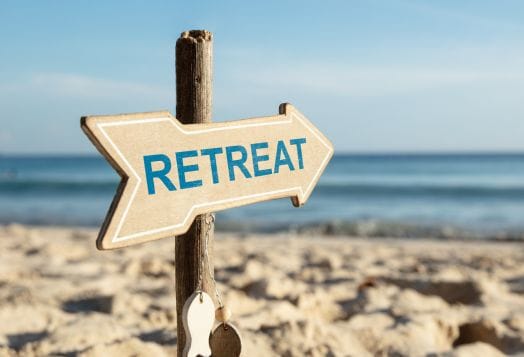Ever wondered why some companies have an amazing team culture? One of their secrets lies in their corporate retreats. These are used to build stronger teams, spark innovation, and yes, actually have fun while doing it. In a world where employees are in hybrid mode, getting together for a retreat has become more important than ever.
Let's dive into how to organise an unforgettable corporate retreat.

Setting Clear Objectives
Planning a retreat doesn’t mean spending a fortune on a luxury resort where everyone has a blast playing volleyball and singing karaoke, but two weeks later, nobody can remember what the retreat was actually about.
Before diving into the exciting parts of retreat planning, you need to lay down a rock-solid foundation. Think of your retreat objectives as the GPS coordinates for your destination – without them, you're just wandering aimlessly.
Defining Your North Star
Start by asking yourself these critical questions:
What specific business challenges are we trying to address?
How will this retreat contribute to our company's long-term vision?
What tangible outcomes do we want to achieve?
Pro tip: Use the SMART framework (Specific, Measurable, Achievable, Relevant, Time-bound) to define your objectives. For instance, instead of "improve team communication," aim to "reduce cross-departmental communication delays by 50% within three months post-retreat."

Choosing the Perfect Venue
Choosing the right venue is all about balancing your dreams with reality. Let’s say you chose a remote mountain lodge for retreat, forgetting to check the Wi-Fi situation. And you have twenty software engineers trying to share a connection barely strong enough to send an email.
So, when selecting your venue, think about the complete package. Sure, that trendy converted warehouse space might look amazing on Instagram, but does it have enough bathrooms for your team of 50? Nothing kills creative brainstorming quite like a queue for the restroom.
Look for spaces that blend functionality with inspiration – maybe a beachfront resort with modern conference facilities or a mountain lodge with both hiking trails and high-speed internet.
Your venue choice can make or break the retreat experience.
Key Considerations for Venue Selection:
Accessibility: Consider travel time and transportation options. A stunning mountain resort might sound perfect, but not if half your team gets motion sickness on winding roads.
Technical Infrastructure:
High-speed internet capacity (minimum 100 Mbps)
Multiple power outlets in meeting spaces
AV equipment compatibility
Backup generators
Space Configuration:
Meeting rooms with flexible layouts
Breakout spaces for small group discussions
Outdoor areas for activities
Quiet zones for refl
How do you balance work and fun in a retreat?
Gowtham Bhaskaran, an event planner with 10 years of experience
“Based on the demographics of the attendees, divide the day into activities and sessions that can interlace fun and business in an organic way.”
Crafting the Perfect Agenda
Creating your retreat agenda is like being a DJ at a wedding – you need to know when to play the hits (important work sessions) and when to slow things down (relaxation time). The key is reading the room and maintaining the energy throughout the event.
Scheduling an intensive strategy session right after lunch is a rookie mistake! You can instead schedule active sessions or outdoor activities for the post-lunch slump, saving the heavy mental lifting for when people are fresh and caffeinated.
Here's a checklist:
Morning Sessions (Peak Energy Time):
Strategic planning workshops
Innovation brainstorming
Technical training
Company vision presentations
Afternoon Activities (Energy Dip Period):
Team-building exercises
Outdoor activities
Skills workshops
Innovation challenges
Evening Programs (Social Time):
Casual networking dinners
Cultural experiences
Free time for personal connections

Tech Stack for Modern Retreats
In 2025, having the right technology at your retreat isn't just helpful – it's essential. Here are some essential tools to consider:
Event Management Platform
Registration and check-in
Digital agenda distribution
Real-time updates
Participant networking
Collaboration Tools
Digital whiteboarding (Miro, FigJam)
Real-time polling (Slido, Mentimeter)
Project management tools (Asana, Trello)
Documentation platforms (Notion, Confluence)
Communication Infrastructure
Dedicated event app
Emergency notification system
Virtual participation options for hybrid setups
Engaging Activities That Actually Work
Gone are the days when trust falls and awkward icebreakers were considered peak team building. Today's activities need to be as dynamic and diverse as your team.
Let’s take the example of a tech company that organised a "Reverse Mentoring Hackathon" where junior developers taught senior executives about emerging technologies while working on real company challenges. The result? Not only will they generate innovative solutions, but they will also break down hierarchical barriers – and yes, the CEO will finally learn what "yeet" means.
Here are a few activities that can help create genuine connections:
Innovation Workshops:
Design thinking sprints
Future scenario planning
Product ideation sessions
Customer journey mapping
Team Building:
Hackathons with cross-functional teams
Social impact projects
Skill-sharing workshops
Cultural exchange activities
Wellness Integration:
Mindfulness sessions
Stress management workshops
Physical activity options
Mental health awareness programs

Logistics–The Hidden Success Factor
The key to success is in the details when it comes to retreat logistics:
Pre-Retreat Planning:
Timeline Development
6 months: Venue selection
4 months: Activity planning
3 months: Technology setup
2 months: Participant communication
1 month: Final confirmations
Budget Management (approx)
Venue costs (40% of budget)
Activities (25%)
Food and beverages (20%)
Technology and materials (10%)
Contingency (5%)
During the Retreat:
On-site coordination team
Emergency response plan
Real-time feedback collection
Documentation and recording
Measuring Success and ROI
Let's talk about measuring success i.e. proving to the finance department that this wasn't just an expensive party.
Key Performance Indicators:
Quantitative Metrics
Employee engagement scores
Project completion rates
Cross-department collaboration metrics
Innovation output measures
Qualitative Assessment
Team feedback surveys
Individual interviews
Behavioural change observations
Long-term impact analysis

Post-Retreat Action Plan
The end of your retreat shouldn't feel like the end of a Netflix series – leaving everyone wondering what happens next. Create a clear action plan that keeps the momentum going.
Let's say your retreat focused on improving customer experience. Here's how the action plan might look:
Week 1-2:
Marketing team drafts new customer journey map
Product team identifies technical improvements
Customer service creates new communication protocols
Month 1:
First prototype of improved onboarding process
Initial customer feedback collection
Resource allocation finalised
Quarter 1:
Pilot program launch
Preliminary impact measurement
Adjustments based on initial results
By the end of the year, you'll have a comprehensive view of how the retreat's insights transformed into tangible business improvements.
Common Pitfalls to Avoid
Over scheduling activities
Neglecting introverts' needs
Focusing too much on work
Ignoring dietary restrictions
Skipping documentation
Lacking clear objectives
Making It Count
Remember, a great corporate retreat is like a perfectly brewed cup of coffee – it takes the right ingredients, proper timing, and careful attention to detail to create something energising and satisfying.
By following this guide, you're well on your way to planning a retreat that your team will be talking about for years to come (for all the right reasons).
Disclaimer: This information provided is intended for general informational purposes only. It is not a substitute for professional advice or guidance. For personalised recommendations or specific concerns, please consult an experienced Event Planner.




